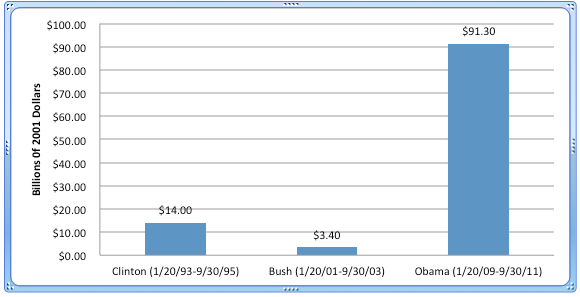- | Regulation Regulation
- | Public Interest Comments Public Interest Comments
- |
Comment on OMB's Draft 2012 Report to Congress on the Benefits and Costs of Federal Regulations
The Office of Management and Budget (OMB) has requested comment on the 2012 Draft Report to Congress on the Benefits and Costs of Federal Regulations and Unfunded Mandates on State, Local and Tribal Entities (hereafter referred to as “the OMB report”). This comment has been produced by Richard A. Williams, Ph.D., of the Mercatus Center at George Mason University, an education, research, and outreach organization that works with scholars, policy experts, and government officials to bridge academic theory and real-world practice.
From the Desk of Richard A. Williams, Ph.D.
June 11, 2012
Mr. Cass Sunstein,
Office of Information and Regulatory Affairs,
Office of Management and Budget, Attn: Mabel Echols,
NEOB, Room 10202,
725 17th Street NW., Washington, DC 20503.
Dear Mr. Sunstein,
The Regulatory Studies Program of the Mercatus Center at George Mason University is dedicated to advancing knowledge of the impact of regulation on society. As part of its mission, the Regulatory Studies Program conducts careful and independent analyses employing contemporary economic scholarship to assess rulemaking proposals and reports from the perspective of the public interest. We appreciate the invitation to comment on the Draft 2012 Report to Congress on the Cost and Benefits of Federal Regulations and hope that our comments will be useful to the Office of Management and Budget.
Sincerely,
Richard A. Williams, Ph.D.
Director for Policy Research
Mercatus Center at George Mason University
3351 North Fairfax Drive, 4th Floor
Arlington VA 22201
The Office of Management and Budget (OMB) has requested comment on the 2012 Draft Report to Congress on the Benefits and Costs of Federal Regulations and Unfunded Mandates on State, Local and Tribal Entities (hereafter referred to as “the OMB report”). This comment has been produced by Richard A. Williams, Ph.D., of the Mercatus Center at George Mason University, an education, research, and outreach organization that works with scholars, policy experts, and government officials to bridge academic theory and real-world practice.
The principal finding of the OMB report is that:
The estimated annual benefits of major Federal regulations reviewed by OMB from October 1, 2001, to September 30, 2011, for which agencies estimated and monetized both benefits and costs, are in the aggregate between $141 billion and $700 billion, while the estimated annual costs are in the aggregate between $43.3 billion and $67.3 billion. These ranges reflect uncertainty in the benefits and costs of each rule at the time that it was evaluated.
OMB maintains that “Aggregating benefit and cost estimates of individual regulations . . . provides potentially valuable information about the effects of regulations” although the “resulting estimates are neither precise nor complete.” However, OMB has not reported the full range of uncertainty for the total costs and benefits of the 2011 regulatory program. OMB should consider including a separate section on the substantial uncertainties associated with estimates of costs and benefits that go beyond the uncertainties reported by the agencies themselves.
In announcing the most recent economic Executive Order, the White House states, “The Executive Order emphasizes the importance of quantification, and it does so with greater clarity and firmness than has been done before.” In the OMB report, the administration claims that the net benefits of rules issued in the first two years have been over $35 billion. This reflects, as shown in a chart in the OMB report, that the net benefits are three times those in the first two years of the Clinton administration and over ten times the first two years of the Bush Administration (see the chart below). Even more, the administration claims, “Under the President’s direction, we have issued rules, in our first three years, with over $91 billion in net benefits – over 25 times the corresponding figure in the first three years of the Bush Administration, and over six times the corresponding figure in the first three years of the Clinton Administration. This is an extraordinary achievement if true—but it is conveniently difficult to verify. Figure 1, taken from the OMB report, demonstrates the administration’s claim for this year.
Figure 1: Total Net Benefits of Major Rules through the Third Fiscal Year of an Administration

Source: OMB, Draft 2012 Report to Congress on the Benefits and Costs of Federal Regulations and Unfunded Mandates on State, Local, and Tribal Entities, 54.

